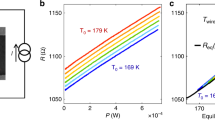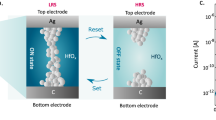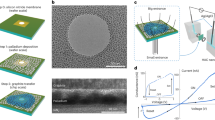Abstract
Resistive switching, a phenomenon in which the resistance of a device can be modified by applying an electric field1,2,3,4,5, is at the core of emerging technologies such as neuromorphic computing and resistive memories6,7,8,9. Among the different types of resistive switching, threshold firing10,11,12,13,14 is one of the most promising, as it may enable the implementation of artificial spiking neurons7,13,14. Threshold firing is observed in Mott insulators featuring an insulator-to-metal transition15,16, which can be triggered by applying an external voltage: the material becomes conducting (‘fires’) if a threshold voltage is exceeded7,10,11,12. The dynamics of this induced transition have been thoroughly studied, and its underlying mechanism and characteristic time are well documented10,12,17,18. By contrast, there is little knowledge regarding the opposite transition: the process by which the system returns to the insulating state after the voltage is removed. Here we show that Mott nanodevices retain a memory of previous resistive switching events long after the insulating resistance has recovered. We demonstrate that, although the device returns to its insulating state within 50 to 150 nanoseconds, it is possible to re-trigger the insulator-to-metal transition by using subthreshold voltages for a much longer time (up to several milliseconds). We find that the intrinsic metastability of first-order phase transitions is the origin of this phenomenon, and so it is potentially present in all Mott systems. This effect constitutes a new type of volatile memory in Mott-based devices, with potential applications in resistive memories, solid-state frequency discriminators and neuromorphic circuits.
This is a preview of subscription content, access via your institution
Access options
Access Nature and 54 other Nature Portfolio journals
Get Nature+, our best-value online-access subscription
$29.99 / 30 days
cancel any time
Subscribe to this journal
Receive 51 print issues and online access
$199.00 per year
only $3.90 per issue
Buy this article
- Purchase on Springer Link
- Instant access to full article PDF
Prices may be subject to local taxes which are calculated during checkout




Similar content being viewed by others
Data availability
All the data supporting the claims and figures of this Letter are available from the corresponding author upon reasonable request.
Code availability
The code used in the simulations supporting this Letter is available from J.d.V. (jdelvallegranda@ucsd.edu) or M.R. (marcelo.rozenberg@u-psud.fr) upon reasonable request.
References
Beck, A., Bednorz, J. G., Gerber, Ch., Rossel, C. & Widmer, D. Reproducible switching effect in thin oxide films for memory applications. Appl. Phys. Lett. 77, 139 (2000).
Waser, R. & Aono, M. Nanoionics-based resistive switching memories. Nat. Mater. 6, 833–840 (2007).
Strukov, D. B., Snider, G. S., Stewart, D. R. & Williams, R. S. The missing memristor found. Nature 453, 80–83 (2008); erratum 459, 1154 (2009).
Kwon, D. H. et al. Atomic structure of conducting nanofilaments in TiO2 resistive switching memory. Nat. Nanotechnol. 5, 148–153 (2010).
Yang, J. J., Strukov, D. B. & Stewart, D. R. Memristive devices for computing. Nat. Nanotechnol. 8, 13–24 (2013).
del Valle, J., Ramirez, J. G., Rozenberg, M. & Schuller, I. K. Challenges in materials and devices for resistive-switching-based neuromorphic computing. J. Appl. Phys. 124, 211101 (2018).
Zhou, Y. & Ramanathan, S. Mott memory and neuromorphic devices. Proc. IEEE 103, 1289–1310 (2015).
Prezioso, M. et al. Training and operation of an integrated neuromorphic network based on metal-oxide memristors. Nature 521, 61–64 (2015).
Schuller, I. K. & Stevens, R. Neuromorphic Computing: from Materials to Systems Architecture https://science.energy.gov/~/media/ascr/pdf/programdocuments/docs/Neuromorphic-Computing-Report_FNLBLP.pdf (US Department of Energy, Washington DC, 2015).
Brockman, J. S. et al. Subnanosecond incubation times for electric-field-induced metallization of a correlated electron oxide. Nat. Nanotechnol. 9, 453–458 (2014).
del Valle, J. et al. Electrically induced multiple metal-insulator transitions in oxide nanodevices. Phys. Rev. Appl. 8, 054041 (2017).
Zimmers, A. et al. Role of thermal heating on the voltage induced insulator-metal transition in VO2. Phys. Rev. Lett. 110, 056601 (2013).
Stoliar, P. et al. A leaky-integrate-and-fire neuron analog realized with a Mott insulator. Adv. Funct. Mater. 27, 1604740 (2017).
Pickett, M. D., Medeiros-Ribeiro, G. & Williams, R. S. A scalable neuristor built with Mott memristors. Nat. Mater. 12, 114–117 (2013).
Imada, M., Fujimori, A. & Tokura, Y. Metal–insulator transitions. Rev. Mod. Phys. 70, 1039 (1998).
Park, J. H. et al. Measurement of a solid-state triple point at the metal–insulator transition in VO2. Nature 500, 431–434 (2013).
Mazza, G., Amaricci, A., Capone, M. & Fabrizio, M. Field-driven Mott gap collapse and resistive switch in correlated insulators. Phys. Rev. Lett. 117, 176401 (2016).
Zhou, Y. et al. Voltage-triggered ultrafast phase transition in vanadium dioxide switches. IEEE Electron Device Lett. 34, 220–222 (2013).
Yang, J. J. et al. Engineering nonlinearity into memristors for passive crossbar applications. Appl. Phys. Lett. 100, 113501 (2012).
Madan, H., Jerry, M., Pogrebnyakov, A., Mayer, T. & Datta, S. Quantitative mapping of phase coexistence in Mott-Peierls insulator during electronic and thermally driven phase transition. ACS Nano 9, 2009–2017 (2015).
Binder, K. Theory of first-order phase transitions. Rep. Prog. Phys. 50, 783 (1987).
Gray, A. X. et al. Ultrafast terahertz field control of electronic and structural interactions in vanadium dioxide. Phys. Rev. B 98, 045104 (2018).
O’Callahan, B. T. et al. Inhomogeneity of the ultrafast insulator-to-metal transition dynamics of VO2. Nat. Commun. 6, 6849 (2015).
Ramírez, J. G., Sharoni, A., Dubi, Y., Gómez, M. E. & Schuller, I. K. First-order reversal curve measurements of the metal-insulator transition in VO2: signatures of persistent metallic domains. Phys. Rev. B 79, 235110 (2009).
Claassen, J. H., Lu, J. W., West, K. G. & Wolf, S. A. Relaxation dynamics of the metal-semiconductor transition in VO2 thin films. Appl. Phys. Lett. 96, 132102 (2010).
Nag, J., Haglund, R. F. Jr, Payzant, E. A. & More, K. L. Non-congruence of thermally driven structural and electronic transitions in VO2. J. Appl. Phys. 112, 103532 (2012).
Vinokur, V. M., Feigel’man, M. V. & Geshkenbein, V. B. Exact solution for flux creep with logarithmic U(j) dependence: self-organized critical state in high-T c superconductors. Phys. Rev. Lett. 67, 915 (1991).
Le Gallo, M., Krebs, D., Zipoli, F., Salinga, M. & Sebastian, A. Collective structural relaxation in phase-change memory devices. Adv. Electron. Mater. 4, 1700627 (2018).
Amir, A., Oreg, Y. & Imri, Y. On relaxation and aging of various glasses. Proc. Natl Acad. Sci. USA 109, 1850–1855 (2012).
Béland, L. K., Osetsky, Y. N., Stoller, R. E. & Xu, H. Slow relaxation of cascade-induced defects in Fe. Phys. Rev. B 91, 054108 (2015).
Sohn, A., Kanki, T., Sakai, K., Tanaka, H. & Kim, D.-W. Fractal nature of metallic and insulating domain configurations in a VO2 thin film revealed by Kelvin probe force microscopy. Sci. Rep. 5, 10417 (2015).
Sharoni, A., Ramirez, J. G. & Schuller, I. K. Multiple avalanches across the metal-insulator transition of vanadium oxide nanoscaled junctions. Phys. Rev. Lett. 101, 026404 (2008).
Wang, S. et al. Ultrafast photo-induced dynamics across the metal-insulator transition of VO2. EPL 118, 27005 (2017).
Zhu, Y. et al. Unconventional slowing down of electronic recovery in photoexcited charge-ordered La1/3Sr2/3FeO3. Nat. Commun. 9, 1799 (2018).
Qazilbash, M. M. et al. Mott transition in VO2 revealed by infrared spectroscopy and nano-imaging. Science 318, 1750–1753 (2007).
Kizuka, H. et al. Temperature dependence of thermal conductivity of VO2 thin films across metal–insulator transition. Jpn. J. Appl. Phys. 54, 053201 (2015).
Valmianski, I. et al. Origin of the current-driven breakdown in vanadium oxides: thermal versus electronic. Phys. Rev. B 98, 195144 (2018).
Kotliar, G., Lange, E. & Rozenberg, M. J. Landau theory of the finite temperature Mott transition. Phys. Rev. Lett. 84, 5180–5183 (2000).
Ridley, B. K. Specific negative resistance in solids. Proc. Phys. Soc. 82, 954 (1963).
Kumar, S. & Williams, R. S. Separation of current density and electric field domains caused by nonlinear electronic instabilities. Nat. Commun. 9, 2030 (2018).
Young, P. H. Electronic Communication Techniques 3rd edn 360–374 (McMillan Publishing, New York, 1994).
Acknowledgements
The development of the materials and devices in this Letter was supported by the Vannevar Bush Faculty Fellowship programme sponsored by the Basic Research Office of the Assistant Secretary of Defense for Research and Engineering and funded by the US Office of Naval Research through grant N00014-15-1-2848. The neuromorphic aspects of this work, including the collaboration between UCSD and CNRS, were supported as part of the Quantum Materials for Energy Efficient Neuromorphic Computing, an Energy Frontier Research Center funded by the US Department of Energy, Office of Science, Basic Energy Sciences under award DE-SC0019273. Part of the fabrication process was done at the San Diego Nanotechnology Infrastructure (SDNI) of UCSD, a member of the National Nanotechnology Coordinated Infrastructure (NNCI), which is supported by the US National Science Foundation under grant ECCS-1542148. J.G.R. acknowledges support from FAPA and Colciencias number 120471250659. J.d.V. and J.T. thank Fundación Ramón Areces for their support with a postdoctoral fellowship. J.d.V. thanks I. Valmianski for helpful discussions.
Reviewer information
Nature thanks Kristjan Haule, Cheol Seong Hwang and the other anonymous reviewer(s) for their contribution to the peer review of this work.
Author information
Authors and Affiliations
Contributions
J.d.V., J.T., J.G.R. and I.K.S. conceived and designed the experiment. J.d.V., Y.K. and M.-H.L. fabricated the samples. J.d.V. and P.S. performed the transport measurements with assistance from G.K. The reflectivity measurements were performed by N.M.V. and J.d.V. P.W. did the COMSOL simulations. F.T. and M.J.R. simulated the relaxation dynamics. J.d.V., P.S. and I.K.S. wrote the manuscript. All authors participated in the discussion of the results and corrected multiple iterations of the manuscript.
Corresponding author
Ethics declarations
Competing interests
The authors declare no competing interests.
Additional information
Publisher’s note: Springer Nature remains neutral with regard to jurisdictional claims in published maps and institutional affiliations.
Extended data figures and tables
Extended Data Fig. 1 Temperature- and voltage-induced IMT in V2O3.
a, Resistance versus temperature in a V2O3 nanodevice. Both the heating and cooling branches are shown. b, Main panel, current versus time when a 200-ns voltage pulse is applied to the device at 132 K. Results for two voltage amplitudes are shown: subthreshold (0.6 V; in blue) and super-threshold (0.7 V; in red). Inset, the probability of firing the IMT (PTrigger) as a function of the voltage amplitude (VApplied). This probability was obtained by observing how many times the IMT was triggered in 100 pulses. The error bars were calculated using the standard deviation of the binomial distribution.
Extended Data Fig. 2 Subthreshold firing and memory effect in V2O3.
a, Applied voltage as a function of time. The pump–probe procedure consists of a super-threshold pulse first applied to trigger the IMT, followed, after a delay time τ, by a subthreshold probe pulse. The dashed line shows VThreshold. b, Current versus time at T = 130 K when the voltage shown in a is applied with a delay τ = 100 μs between the pulses. The transition is triggered in both cases. c, Probability that the probe pulse will trigger the IMT (PTrigger) as a function of τ, at T = 130 K. This probability was obtained by observing how many times the IMT was triggered in 100 pulses. The error bars were calculated using the standard deviation of the binomial distribution. PTrigger is plotted for different VProbe amplitudes: 0.5VTh, 0.6VTh, 0.7VTh and 0.8VTh (see key; VTh = VThreshold). Solid lines are fits to curves of the type αt−β + γ, where α, β and γ are fitting parameters obtained by the least-squares method. d, Delay time τ50%, at which the firing probability is 50%, plotted against T for a pulse with amplitude 0.6 VThreshold. τ50% was calculated using the fitting curves shown in c. Error bars were derived by uncertainty propagation, using the standard error of the fit.
Extended Data Fig. 3 Frequency discrimination using subthreshold firing in VO2.
a, Top panels, voltage pulses applied to the gap versus time. The first super-threshold pulse is followed by a series of subthreshold voltages separated by 10 μs (left) or 5 μs (right). Bottom panels, current versus time when the pulses are applied. Note that when the pulse separation is 5 μs, each voltage pulse refreshes the memory of the device, allowing for repeated subthreshold firing. The temperature was 330 K. b, Attenuation of a sinusoidal signal through a nanodevice as a function of the signal frequency. The output voltage was measured on a 50-Ω load resistor. Several signal amplitudes are shown (see key; Vth = VThreshold). The device was initiated with a super-threshold voltage pulse before the sine signal was sent. The temperature was 325 K.
Extended Data Fig. 4 COMSOL Multiphysics simulations.
a, Voltage versus current in a 100-nm VO2 nanogap. A 260-Ω load resistance was used to mimic contact resistance in the probe station. Base temperature in the simulation was 325 K. b, Current versus time when 200-ns voltage pulses of different amplitude are applied at t = 0 ns. The simulation temperature was 325 K. Different voltage amplitudes are used: 1.89 V (<VThreshold), 1.90 V, 2.00 V and 2.11 V. Note that the delay times are of the order of nanoseconds or tens of nanoseconds, similar to the experimental results.
Extended Data Fig. 5 Landau-type model of resistive switching.
a, Schematic representation of the resistor network used to model VO2. Each node of the network is connected to its nearest neighbours by a resistor. The value of the resistor depends on the local state: metallic (dark grey) or insulating (white). A load resistor (Rload) is placed in series with the network. b, Free energy (F) as a function of the order parameter η for three different temperatures (331 K, 340 K and 349 K). The node is metallic if η < 0 and insulating for η > 0.
Extended Data Fig. 6 Simulation results.
a, Resistance (R) versus temperature (T) of the simulated network. b, Simulated current (I) versus voltage (V) at T = 330 K. c, Simulated current (I) versus VSample at T = 330 K. d, τ50% versus temperature. τ50% is defined as the time at which there is a 50% probability of triggering the transition with a voltage pulse amplitude of 0.6 VThreshold, using a pump–probe protocol similar to the experiments. e, Probability (PTrigger) that a probe pulse with amplitude 0.6 VThreshold will trigger the transition as a function of the separation time between pulses (τ). The simulation temperature was 335 K.
Supplementary information
Video 1
: Simulated subthreshold firing using a resistive network model. Simulated triggering of the IMT by two voltage pulses. The first pulse is above VThreshold, while the second one is below VThreshold. The system was simulated using the resistive network model described in the methods section. Top panel: V/VThreshold vs time. Middle panel: 2D temperature distribution as a function of time. Bottom panel: 2D distribution of metallic (black) /insulating (yellow) domains as a function of time. The time axes is shown in arbitrary units for all cases
Rights and permissions
About this article
Cite this article
del Valle, J., Salev, P., Tesler, F. et al. Subthreshold firing in Mott nanodevices. Nature 569, 388–392 (2019). https://doi.org/10.1038/s41586-019-1159-6
Received:
Accepted:
Published:
Issue Date:
DOI: https://doi.org/10.1038/s41586-019-1159-6
This article is cited by
-
Artificially controlled nanoscale chemical reduction in VO2 through electron beam illumination
Nature Communications (2023)
-
Bimodal ionic photomemristor based on a high-temperature oxide superconductor/semiconductor junction
Nature Communications (2023)
-
A review of Mott insulator in memristors: The materials, characteristics, applications for future computing systems and neuromorphic computing
Nano Research (2023)
-
2D materials for intelligent devices
Science China Physics, Mechanics & Astronomy (2023)
-
Nanoscale self-organization and metastable non-thermal metallicity in Mott insulators
Nature Communications (2022)
Comments
By submitting a comment you agree to abide by our Terms and Community Guidelines. If you find something abusive or that does not comply with our terms or guidelines please flag it as inappropriate.



